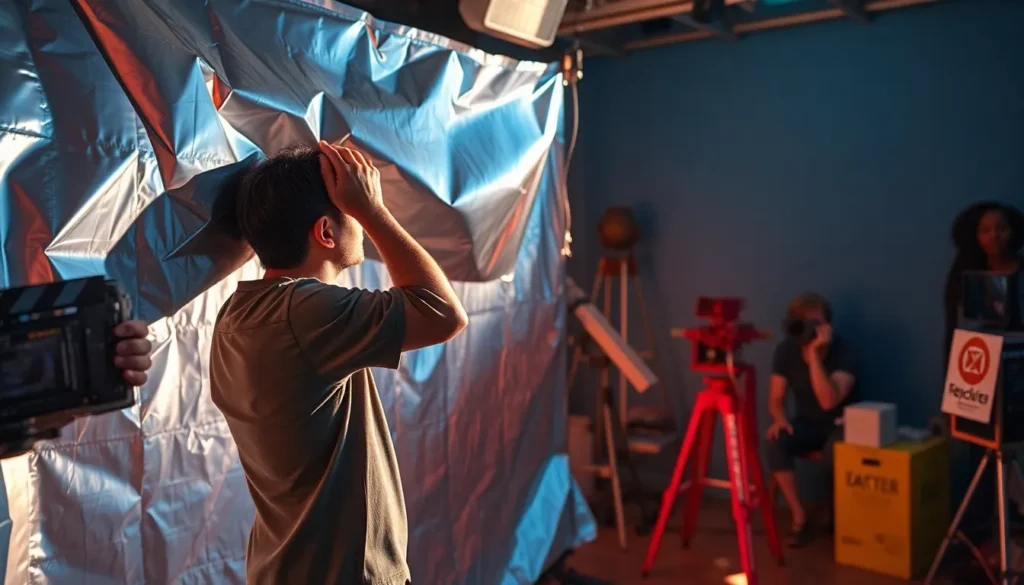Table of Contents
ToggleLights, camera, action! But wait—what’s that glint on the screen? Enter film foils, the unsung heroes of the cinematic world. These shiny little wonders not only enhance visuals but also add that extra pop that keeps audiences glued to their seats. Imagine a blockbuster without the dramatic flair of a perfectly placed foil. It’s like a pizza without cheese—just wrong!
Overview of Film Foils
Film foils play a crucial role in shaping the visual narrative of a film. Various types of foils, such as silver, gold, and colored options, contribute unique effects to scenes. Silver foils reflect light and create a bright, vibrant atmosphere. Gold foils, on the other hand, provide a warm and luxurious feel that enhances dramatic moments.
Different filmmakers utilize these foils to achieve specific looks for their projects. They can soften harsh shadows, highlight key subjects, or add dimension to flat compositions. By manipulating light and texture, foils help create depth and richness in cinematography.
Foils are not limited to traditional materials; filmmakers also explore innovative solutions like Mylar or aluminum. These alternatives often offer enhanced durability and versatility, accommodating various shooting environments. In green screen applications, film foils can assist in achieving seamless blending between foreground subjects and backgrounds.
The measurement of reflectivity plays a significant role in selecting the appropriate foil. A higher reflectivity rating often necessitates careful placement to avoid overpowering subject illumination. Filmmakers frequently experiment with angles and distances to optimize their usage without sacrificing natural lighting.
Employing film foils enriches the visual storytelling process. Their consistent application can transform a standard shot into a breathtaking frame. Ultimately, filmmakers rely on these tools to craft a captivating visual experience that resonates with audiences.
Types of Film Foils

Several distinct types of film foils enhance filmmaking. Each type serves a unique purpose, contributing to the overall quality of visuals.
Metalized Film Foils
Metalized film foils create striking effects in cinematography. These foils, often made with materials like aluminum, provide reflective surfaces that amplify light. Properties of metalized foils include high reflectivity, making them ideal for adding brilliance to scenes. Filmmakers frequently choose silver and gold varieties for their reflective capabilities. Silver foils deliver a cool, vibrant glow, while gold foils impart warmth and sophistication. Strategically placing these foils can soften shadows and emphasize subjects, enhancing the overall composition.
Barrier Film Foils
Barrier film foils offer essential protection in various filmmaking contexts. Constructed from durable materials, they prevent moisture and oxygen from affecting the contents of packaging or storage. These foils help maintain the quality of film equipment, preventing damage from environmental factors. Options include clear and opaque versions, catering to different visual needs. Filmmakers utilize barrier foils not only for equipment preservation but also to ensure consistency in lighting and visuals. Selecting the right barrier film foil is crucial for maintaining a professional appearance in final productions.
Applications of Film Foils
Film foils find extensive use across various industries, significantly enhancing functionality and aesthetic appeal.
Packaging Industry
Film foils play a vital role in the packaging industry, used for flexible packaging solutions. They ensure products remain visually appealing through their shiny surface and vibrant colors. Various food products, cosmetics, and pharmaceutical items benefit from the barrier properties provided by metalized or barrier film foils. Durability ensures that packaging withstands transport and storage conditions while maintaining product integrity. Additionally, branding becomes more effective with custom-printed designs on these foils, helping products stand out on store shelves.
Food Preservation
In food preservation, film foils serve multiple critical purposes. They extend the shelf life of perishable items by providing a barrier against moisture and oxygen. Silver and gold foils protect foods by reflecting light, which helps inhibit microbial growth. Properly sealed food wrapped in these foils retains flavor and freshness longer than alternatives. Restaurants frequently utilize film foils for takeout packaging, ensuring customers receive their meals in optimal condition. These features make film foils indispensable in maintaining food quality and safety.
Advantages of Film Foils
Film foils offer numerous benefits that enhance filmmaking and other industries. Their reflective qualities enhance visual aesthetics, creating depth and vibrancy in scenes. Silver foils reflect light effectively, producing a cool and energetic ambiance, whereas gold foils impart warmth to dramatic moments. Filmmakers often choose these options based on the mood they want to convey.
In addition to enhancing visuals, film foils contribute to shadow management. By softening harsh shadows, they highlight subjects and create more balanced compositions. Durability stands as another significant advantage. Foils manufactured from Mylar and aluminum withstand wear and tear, making them ideal for various filming scenarios, including those that utilize green screens.
Barrier properties also play a key role. Barrier film foils, designed to protect against moisture and oxygen, prevent damage to essential equipment. They ensure visuals remain consistent throughout filming, which is vital for professional standards.
Customizability adds to the appeal of film foils. Filmmakers can print designs on foils, enabling branding opportunities in packaging applications. This flexibility benefits sectors such as food preservation, cosmetics, and pharmaceuticals, where appealing presentation and protection are crucial.
Cost-effectiveness is an essential advantage worth mentioning. Film foils are generally affordable, providing a high-quality solution for enhancing production value without significantly increasing budgets. These qualities establish film foils as indispensable tools for filmmakers and various industries alike. Their ability to enrich storytelling and maintain product integrity underscores their significance across multiple sectors.
Challenges and Innovations in Film Foils
Film foils face several challenges despite their versatility and essential role in filmmaking and various applications. Environmental concerns arise from traditional materials, prompting a shift towards sustainable options. Many filmmakers seek alternatives that minimize waste while maintaining high reflectivity and durability. Innovations in this area include the development of biodegradable and recyclable foils, enhancing eco-friendly practices in production.
Technological advancements also play a crucial role in improving the performance of film foils. Enhanced coatings and treatments increase durability, allowing foils to withstand harsh conditions during shoots. These innovations contribute to better reflectivity and control over lighting, essential for achieving the desired visual impact. Manufacturers increasingly use advanced materials such as Mylar and new composites, enhancing their application in diverse cinematic environments.
Changes in consumer preferences force the industry to adapt. The growing demand for unique, eye-catching visuals drives filmmakers to experiment with specialty foils. Consequently, exploring varied textures and finishes adds depth and uniqueness to scenes, pushing creative boundaries. This exploration presents an opportunity for designers to create custom solutions tailored to specific production needs.
Integration of digital technologies offers new avenues for foil application. Using LED lighting alongside film foils allows for dynamic visual storytelling, creating vibrant atmospheres that resonate with audiences. Moreover, digital print technology provides avenues for custom designs and branding, particularly in packaging applications.
The film industry continuously evolves, presenting filmmakers with challenges and opportunities. Adapting to environmental concerns, technological advancements, and changing consumer preferences shapes the future of film foils. Innovations in materials and applications drive the industry forward, ensuring film foils remain indispensable in creating captivating narratives.
Film foils play a vital role in both filmmaking and various industrial applications. Their unique properties enhance visual storytelling while ensuring products remain protected and appealing. As the industry evolves, filmmakers and manufacturers alike are embracing innovative materials that balance performance with sustainability. This commitment to quality and creativity ensures that film foils will continue to be an essential tool in crafting memorable experiences. Whether on screen or in packaging, the impact of film foils is undeniable, transforming ordinary moments into extraordinary ones.







